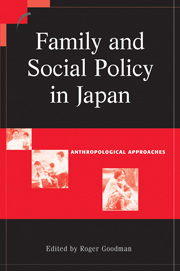Book contents
- Frontmatter
- Contents
- List of Illustrations
- Acknowledgements
- Contributors
- A note to the reader
- 1 Anthropology, policy and the study of Japan
- 2 Toward a cultural biography of civil society in Japan
- 3 Pinning hopes on angels: reflections from an aging Japan's urban landscape
- 4 Reproducing identity: maternal and child healthcare for foreigners in Japan
- 5 State, standardisation and ‘normal’ children: an anthropological study of a preschool
- 6 Child abuse in Japan: ‘discovery’ and the development of policy
- 7 Touching of the hearts: an overview of programmes to promote interaction between the generations in Japan
- 8 Death policies in Japan: the state, the family, and the individual
- 9 Embodiment, citizenship and social policy in contemporary Japan
- Index
8 - Death policies in Japan: the state, the family, and the individual
Published online by Cambridge University Press: 05 July 2014
- Frontmatter
- Contents
- List of Illustrations
- Acknowledgements
- Contributors
- A note to the reader
- 1 Anthropology, policy and the study of Japan
- 2 Toward a cultural biography of civil society in Japan
- 3 Pinning hopes on angels: reflections from an aging Japan's urban landscape
- 4 Reproducing identity: maternal and child healthcare for foreigners in Japan
- 5 State, standardisation and ‘normal’ children: an anthropological study of a preschool
- 6 Child abuse in Japan: ‘discovery’ and the development of policy
- 7 Touching of the hearts: an overview of programmes to promote interaction between the generations in Japan
- 8 Death policies in Japan: the state, the family, and the individual
- 9 Embodiment, citizenship and social policy in contemporary Japan
- Index
Summary
The inscription on Stendhal's tombstone, ‘He lived, wrote, and loved,’ sums up his life in one short sentence. By contrast, the inscription on the typical Japanese tombstone reads ‘Ancestral grave of X family’ and contains no reference at all to the lives of the individuals buried in it. Today, most Japanese assume incorrectly that the practice is an age-old tradition, whereas in fact it became widespread only during the Meiji period (1868–1912) as a result of the government's attempt to ‘modernise’ the nation.
In this paper, I examine death-related policies in Japan over the last 130 years to reveal the complex and dynamic process of policy implementation. First, I review death policies in the early Meiji period and demonstrate how the state's control of death was tied to its drive to modernise the country and how death policies, especially those relating to household-based ancestor worship, facilitated the new regime's control over the family and the individual. Next, I deal with death-related policies that developed after World War II in the period of democratisation. I am particularly concerned with the lingering effects of the household principle on the new policies, and the extent to which these new policies have failed to keep up with the rapid pace of change in contemporary Japan. Finally, I explore the impact of death policies on people's lives and their responses to policy change.
- Type
- Chapter
- Information
- Family and Social Policy in JapanAnthropological Approaches, pp. 177 - 199Publisher: Cambridge University PressPrint publication year: 2002
- 23
- Cited by

